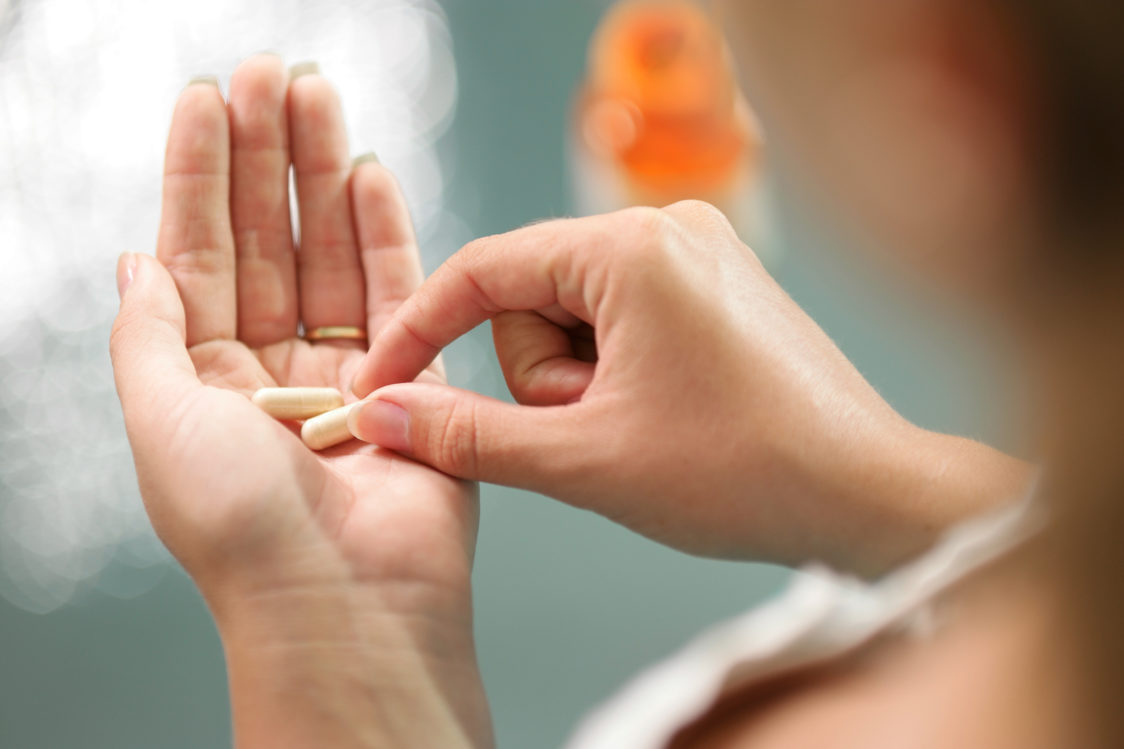Table of Contents
Vitamin D, also known as the sunshine vitamin, is a substance we’ve been hearing about more and more lately. And no wonder. Research shows that almost half of the population is deficient in this vitamin, which carries a number of health risks. These include negative effects on bone health, muscle function, the immune system and overall body health. It is therefore in everyone’s interest to ensure that they are getting sufficient amounts of vitamin D.
The best natural source of this micronutrient is sunlight. However, this is not always in abundance during the year and cannot be relied on completely. Plus, when we spend most of our day indoors and slather ourselves with high SPF creams outside, UVB rays are less likely to do their job of helping our bodies make vitamin D.
This makes it all the more important to ensure sufficient intake of vitamin D from your diet and, if necessary, supplements.
What is vitamin D?
Vitamin D is a fat-soluble vitamin. Although it requires a simultaneous intake of fat for its proper absorption, it has the advantage of being able to be stored in the body’s adipose tissue. This then acts as a reservoir for this substance. The disadvantage of this is the risk of overdose, which is not so much the case with water-soluble vitamins. [15]
It is found in two naturally occurring forms that serve as precursors to this vitamin.
What are the different forms of vitamin D?
- Ergocalciferol (vitamin D2): vitamin D found mainly in plant sources.
- Cholecalciferol (vitamin D3): found mainly in animal foods. Compared to vitamin D2, studies show that it has a better availability in the body. [1–2]
What happens in the body when you take vitamin D?
The inactive forms of D2 and D3 are then converted in the body to calcidiol (25-hydroxyvitamin D), which is then converted to the biologically active form of vitamin D in the form of calcitriol (1-25 dihydroxyvitamin D). Interestingly, after this conversion, it has properties that are more similar to a steroid hormone than a vitamin. It can bind to vitamin D receptors (VDR), which are found in almost every cell of the human body. It is thus involved in the most basic processes such as cell reproduction and specialisation. [3-4]

Why is vitamin D so important?
Thanks to its complex mechanism of action, this micronutrient is involved in a wide range of processes affecting proper functioning of the body.
1. Contributes to the normal absorption of calcium and phosphorus
The active form of vitamin D (calcitriol) increases the absorption of these minerals in the small intestine. In the case of calcium, it can increase absorption from 10% to 15-40%, in the case of phosphorus from 60% to 80%. As a result, it helps to increase the levels of these important minerals in the body. [5]
2. Supports the maintenance of normal calcium blood levels
Calcitriol also has an effect on osteoclasts (bone cells), which, when necessary, can be induced to release calcium stores from the bone into the blood in cooperation with parathyroid hormone. In addition, it promotes the resorption of calcium in the kidneys. As a result, this mineral can then be utilised for proper blood clotting, nerve transmission and other bodily functions. [5]
3. Contributes to normal bone health
This is probably mainly due to the beneficial effect of vitamin D on calcium levels and proper bone mineralisation. It thus supports the maintenance of optimal bone density, helping to keep bones strong and resilient. This is why calcium often appears in dietary supplements with vitamin D. An even better synergistic combo for bone health is calcium with vitamin D and vitamin K. [1]
4. Promotes the maintenance and condition of teeth
Vitamin D promotes the absorption of calcium and phosphorus, which form the basis of dental structures. It thus contributes to the mineralisation of teeth, which takes place not only during childhood when teeth are growing, but also during adult life. As a result, it helps to protect teeth from demineralisation (decalcification), which can result in, for example, more frequent tooth decay. [6]
5. Contributes to the maintenance of proper muscle function
Activated vitamin D acts on receptors located in the muscles. It also affects muscle contraction, which alternates between contraction (shortening) and relaxation (relaxation). Calcium and magnesium are mainly involved in this process, but vitamin D also plays a role. It is also associated with muscle growth and the protection of muscle cells from breakdown. As a result, it can also have a positive effect on strength performance. [7]
6. Supports proper immune system function
Calcitriol is able to activate T and B cells of the immune system through receptors. They play an important role in the body’s defences, helping to protect the body from attack by bacteria or viruses that cause various respiratory and other conditions. [7]

7. Important for brain health and cognitive function
In early childhood, vitamin D is involved in brain and nervous system development. But even in adulthood it is important for maintaining cognitive functions such as memory, thinking and concentration. [8]
In addition, it plays a role in the production of neurotransmitters such as dopamine and serotonin, which are also closely related to mood and emotions. [8]
8. Plays a role in blood sugar metabolism
Vitamin D can also affect blood sugar metabolism. It also has receptors in the pancreas, where it has a positive effect on pancreatic cells that produce the hormone insulin, which lowers blood sugar (glycaemia). [1]
9. Involved in the process of cell division
Vitamin D receptors are present in virtually every cell of the body. This gives vitamin D the opportunity to influence their growth, reproduction and specialisation. [1]
This happens most intensely during foetal development in pregnancy. However, the process of cell division takes place in the body even after birth throughout the course of life. [1]
Vitamin D deficiency
When you read about vitamin D, you usually find a mention of its deficiency in the population right at the beginning. There is talk of about a billion people who are deficient in this substance. You may even see the term vitamin D deficiency pandemic. But are people really that bad in terms of vitamin D intake? [9]
Before answering this question, let’s define what vitamin D deficiency actually means. The level of this substance is determined in the laboratory from blood serum. The amount of calciol (25-hydroxyvitamin D) is determined, which is the most telling of the current state and level of this substance in the body.
Vitamin D deficiency reference values
- Vitamin D deficiency is defined as a fall in calcidiol levels below 50 nmol/l (20 ng/ml). This condition is associated with bone deterioration, which is manifested by reduced bone density and increased brittleness. It is particularly dangerous in the elderly, when a fall can become a problem.//
- Serious vitamin D deficiency is defined as a drop in calcidiol below 30 nmol/l (12 ng/ml). This is a critical condition that increases the risk of infections, cancer and other serious diseases in addition to bone deterioration. [10]
According to research, what percentage of people in the population are deficient in vitamin D?
- Vitamin D deficiency affects approximately 40% of Europeans, of whom 13% are severely deficient. [10]
- In the USA, 24% of the population is affected, of whom 5.9% are severely deficient, according to research. [10]
- Among the Canadian population, 37% were found to be vitamin D deficient, of whom 7.4% were severely deficient. [10]
- In some developing countries, such as India, Pakistan and Afghanistan, the number of people in the population with critical vitamin D deficiency is above 20%, which is interesting given the sunny climate in these countries. Perhaps the use of protective clothing plays a role. [10]
- Vitamin D deficiency has also been found in professional athletes. Of the 2313 individuals tested in the study, 56% were found to be deficient in this micronutrient. [7]
- Individuals training in gyms and other indoor environments are at higher risk due to the absence of sunlight. However, vitamin D deficiency has also been found in soccer players or skiers who spend more time outdoors. [7]
These figures clearly indicate that low vitamin D levels are a global problem. An unpleasant surprise are the levels found in athletes, who would probably not be expected to be deficient to such a large extent. A possible explanation is training indoors or outdoors in the early morning or evening when the sun’s rays are not as strong. Another factor may also be the use of sunscreens with a high SPF factor, which partially inhibits vitamin D production in the skin. [7]

Who is at risk of vitamin D deficiency?
We obtain vitamin D mainly through a remarkable chemical reaction in our skin, which occurs with the help of UVB radiation. If you don’t spend much time in the sun (at least 5-15 minutes without sunscreen), especially between 10am and 2pm when the rays are strongest, you may be at risk of insufficient natural production of this vitamin. [11]
In addition, if you cover your skin with clothing and don’t go out in the sun without applying a high SPF cream, the situation can become even worse. Protecting your skin from the sun’s rays is of course necessary, but a side effect is reduced vitamin D synthesis. The age and pigmentation of your skin also has a significant effect. However, the causes of vitamin D deficiency may be multifactorial.
Vitamin D deficiency may put at risk:
- Long-term completely breastfed babies: breast milk alone contains only a small amount of vitamin D. Therefore, breastfed babies are usually given vitamin D drops.
- Older people: the skin’s ability to produce vitamin D decreases with age. Older people also tend to spend more time indoors therefore limiting their exposure to sunlight.
- People with darker skin tones: they have more melanin in their skin, which reduces the skin’s ability to make vitamin D.
- Vegans, vegetarians and people with lactose intolerance or milk allergy: Have fewer or no food sources of vitamin D in their diet, which include fish and seafood or fortified dairy products.
- People with gastrointestinal, liver, or kidney disease: they may experience impaired absorption or impaired metabolism (conversion to the active form) of vitamin D. Examples of such conditions include Crohn’s disease, coeliac disease, or impaired liver or kidney function.
- People who are overweight or obese: Since it is a fat-soluble vitamin, it is naturally stored in fat tissue. In people who have more of it, this leads to greater isolation of vitamin D, which may then be missing in other parts of the body. Obese individuals often need to take in slightly more vitamin D compared to people who are underweight. [1]
To what extent can the use of sunscreen reduce the production of vitamin D in the skin?
Sunscreens with SPF help protect our skin from the negative effects of UVB rays. However, using them can also reduce vitamin D production.
What is the right thing to do? Tanning without SPF cream or risking vitamin D deficiency? According to studies, sunscreens can reduce the synthesis of vitamin D in the skin, but it turns out that the effect is not that great. Improper use of SPF cream probably plays a role, as does the fact that skincare products with SPF cannot block 100% of UVB rays. So if you are also getting vitamin D from food and supplements, using sunscreen is probably not that big of a risk for deficiency of this nutrient. [29]
If you like to tan and are wondering how best to promote a tan and healthy-looking skin, check out our article The Best Foods and Nutrients for a Bronze Tan and Youthful Skin.

Testing vitamin D levels in the blood
The best way to find out if you have optimal levels of vitamin D in your blood is to see your doctor for a blood test or take a home diagnostic test.
- Doctor’s tests: you can find out the amount of vitamin D in your body by taking blood samples and having them analysed by a laboratory. You need to make an appointment with your doctor for these tests.
- Vitamin D test: you can conveniently order this test at home without having to go anywhere. Use the test kit to take a few drops of blood from the tip of your finger. You then send the sample to a laboratory to be evaluated for free. The results will be sent to your app, email or other means depending on the specifics of the manufacturer. In the table below, you can then compare your results to the levels commonly used to evaluate your blood vitamin D levels.
Vitamin D reference values according to the Institute of Medicine (IOM)
Evaluation | Levels of calcidiol in blood serum |
|---|---|
| Serious deficit | |
| Deficit | 30–50 nmol/l (12–20 ng/ml) |
| Borderline value between deficiency and sufficiency | 50–75 nmol/l (20–30 ng/ml) |
| Sufficient quantity for most people | 75–125 nmol/l (30–50 ng/ml) |
| High levels (risk of overdose and toxicity) | >125 nmol/l (>50 ng/ml) |
*1 ng/ml = 2,5 nmol/l [25]
The values for defining vitamin D levels have changed over the years. You may also have come across different figures among health organisations. However, most experts currently consider levels below 75 nmol/l (30 ng/ml) to be a vitamin D deficiency. A range of 75 nmol/l (30 ng/ml) to 125 nmol/l (50 ng/ml) is most often considered optimal. In the case of toxic doses, we also find different information. According to some sources, the level may be higher than 150 ng/ml. [10, 31]
You might be interested in these products:
Symptoms of vitamin D deficiency
A lack of vitamin D (vitamin D hypovitaminosis) most often evokes weak and brittle bones. But this is not the only symptom of this deficiency. It can also have negative effects in other areas of our health.
1. A deterioration in bone condition
Historically, children with a deficiency of this nutrient developed rickets. This is characterised by reduced mineralisation (softening) of the bones, skeletal deformity and musculoskeletal pain. It is also associated with delayed development, muscle spasms, impaired dental health and abnormal heart function. In adulthood, people with vitamin D deficiency are at risk of osteomalacia or osteoporosis. These diseases have in common a loss of bone mass that can result in more frequent fractures, which is especially critical in the elderly. [1]
2. Muscle weakness
Fractures are most often caused by a fall. This occurs when we fail to maintain stability and let the force of gravity pull us down. Interestingly, studies show that poor stability and more frequent falls are another consequence of vitamin D deficiency. People with this deficiency have been observed to have impaired muscle function and weakness as well as an overall reduced physical performance. [12]
3. Impaired immunity and wound healing
If you go from one cold to another and somehow you can’t get out of the cycle of illnesses, it may be due to vitamin D deficiency. According to research, it is often linked to autoimmune diseases (rheumatoid arthritis, lupus) and reduced protection against viruses or bacteria. Weakened immunity can also result in slower wound healing, which vitamin D also influences. [13]
Wondering what else affects immunity and how to support it? Read our article 15 Tips to Strengthen Your Immune System and Protect Your Health.

4. Increased fatigue and impaired sleep
If you’ve been experiencing a recent drop in energy, muscle weakness and difficulty concentrating, it may also be a sign of vitamin D deficiency. In fact, this is often found in people with these conditions. It can also be related to poor sleep quality and insomnia, which is another cause of fatigue. It is not yet clear what exactly is behind this effect. However, experts believe that vitamin D has a role to play in brain function, where it acts on areas that regulate sleep and cognitive function. [14-15]
If you’re still struggling with fatigue and don’t know what’s the cause behind it, you may find the answer in our article Why Are You Always Tired? The 7 Most Common Causes and Their Solutions.
5. Greater risk of various health problems
A number of studies have shown a link between vitamin D deficiency and certain types of disease. For example, it has been linked to a higher risk of type 2 diabetes, certain cancers, heart disease, multiple sclerosis, depression, Parkinson’s and Alzheimer’s disease.
The relationship between vitamin deficiency and the onset of these health problems is not yet clear, even for experts working on this topic. For now, however, we can say that there is a link and we will need to wait for more detailed information in upcoming research. [1]
Vitamin D deficiency is associated with a number of health risks, including excessive sweating, acne and blurred vision. However, there is not yet enough scientific evidence to support its impact on these problems.
3 areas of life that sufficient vitamin D intake can benefit you
Optimal vitamin D intake is important for overall health. Its importance increases with exercise as it supports bone and muscle function. In addition, it can help you concentrate or to solve a difficult puzzle due to its effect on cognitive function.
1. Supports your physical health
Healthy levels of vitamin D will benefit your health in several ways. According to studies, it can help protect against common seasonal illnesses, but it can also help prevent the onset of serious health problems.
1. 1 A stronger immunity
Vitamin D primarily supports immune function, which acts as a protective shield. This makes you more resistant to viruses, bacteria and other pathogens that try to penetrate this shield and cause health problems. As a result, sufficient intake of this substance can help protect against the onset of colds, flu and other respiratory diseases. [1]
Another way to boost immunity is by cold water therapy. You can read everything you need to know about it in our article How to Get Stronger Immunity Thanks to Cold Water Therapy?
1. 2 Supports heart health
Vitamin D may also have anti-inflammatory effects, which is one of the factors that may be beneficial for heart health. Studies suggest that sufficient vitamin D intake may also help protect against high blood pressure (hypertension) and other cardiovascular problems. In one study, participants with higher levels of this micronutrient had as much as a 60% lower risk of developing heart problems compared to those with lower vitamin D levels. [16]
1. 3 May reduce your risk of certain cancers
Researchers have also found a link in studies between vitamin D levels and a lower incidence of certain cancer types. They found, for example, that people with higher levels of vitamin D in their blood were half as likely to develop colon cancer compared to those with lower levels. Further research is needed in this area, but the results from the research carried out thus far are promising. [16]
1. 4 Reduces your risk of developing type 2 diabetes
Vitamin D has a positive effect on the function of the pancreas, which produces insulin needed to regulate blood sugar. According to studies, supplementation with this substance has led to improved tissue sensitivity to insulin (insulin sensitivity). For example, people with type 2 diabetes who were vitamin D deficient experienced a 60% improvement in this area. Adequate levels of this micronutrient thus contribute to protection against insulin resistance, which is a risk factor for type 2 diabetes. [17]
If you are interested in other ways to enhance sugar metabolism, read our article Insulin Sensitivity – How to Increase Insulin Sensitivity and Prevent Insulin Resistance?

2. Contributes to the preservation of cognitive function and mental health
Getting enough vitamin D is important not only for the brains of growing children, but also for adults, which research shows can help maintain a healthy nervous system and brain function. It is also associated with beneficial effects on the mind.
2. 1 Reduces the risk of neurological diseases
Vitamin D has been shown in studies to have a positive effect on the nervous system, which controls the function of all organs. This is probably due to its ability to protect nerve cells (neurons) from damage by oxidative stress and other negative influences. [18]
In one study, increasing vitamin D to levels above 30 ng/ml led to a lower risk of developing Alzheimer’s or Parkinson’s disease and multiple sclerosis. In people over 65, it had a positive effect on maintaining healthy cognitive functions such as memory and thinking. Vitamin D is also commonly used as part of a comprehensive approach to managing these diseases. [1, 18]
To find out what else can improve memory and other brain functions, read our article How to Improve and Maintain Concentration While Working and Studying?
2. 2 Supports mental health
Optimal vitamin D levels are also associated with positive effects on mental health, mood and overall well-being. However, the best results in studies have been achieved when combined with physical activity. Therefore, it is not entirely clear how big a role vitamin D supplementation played in this. [9]
Vitamin D administration is also common in people diagnosed with depression as part of a comprehensive approach. In one study, for example, there was a 42% improvement in symptoms after taking 4000 IU of vitamin D for one month followed by two months of 2000 IU. [15]
If you are wondering what other substances can help with maintaining your mental well-being, read our article Adaptogens: Natural Substances That Help Manage Stress.

3. Contributes to better sports performance
The positive effect of vitamin D on bone health and muscle function speaks for itself. We simply need this substance for movement. Athletes who want the best possible results should ensure that they have an adequate intake of vitamin D and regularly check the level of vitamin D in their body.
What are the main benefits of vitamin D for athletes according to studies?
- It promotes the maintenance of healthy bones, which are then more resistant to fractures.
- It contributes to proper muscle function.
- It is involved in the growth of new muscle cells and increasing the volume of existing ones.
- Thanks to its properties, it can improve muscle contraction and strength capabilities.
- It is also associated with a beneficial effect on VO2max, a parameter of efficient oxygen utilisation. [7]
Magnesium is also important for athletes. To learn more about this mineral, read our article Cramps, Fatigue, Irritability. What Else Does Magnesium Affect?

How to supplement vitamin D?
It is no coincidence that vitamin D is referred to as the sunshine vitamin. We obtain it mainly from UVB rays. When we are outdoors, we combine pleasant sun exposure with the useful production of this substance. However, there is not always enough sunshine, so food sources and supplements come into play.
1. Vitamin D from sunlight
Solar (UVB) radiation is the most natural source of vitamin D. When the sun’s rays hit our skin, the substance 7-dehydrocholesterol begins to absorb them, which is then converted into vitamin D3. From this, through metabolic processes, the biologically active calcitriol is formed. However, we cannot rely 100% on the production of vitamin D in the skin. It is actually influenced by a number of external factors.
What can negatively affect the production of vitamin D in the skin?
- Seasonal: during autumn and winter, we spend more time indoors and wrap ourselves in more layers of clothing. Also, the sun shines less during this time. This reduces the skin’s exposure to UVB rays.
- Time of day: the sun’s rays are strongest from about 10am to 2pm. If we go out in the morning and evening, vitamin D synthesis is likely to be somewhat less efficient.
- Altitude: at higher altitudes, UVB rays are generally stronger and more effective.
- Air pollution: this reduces the range of UVB rays and their impact on our skin.
- Skin pigmentation: the skin pigment melanin can absorb UVB radiation, reducing the production of vitamin D in the skin. People with darker skin tones naturally produce less vitamin D in their skin.
- Using creams with a high SPF: by protecting our skin from the negative effects of sunlight, we are also partially reducing our ability to naturally produce vitamin D. [22]
So many factors come into play that it’s hard to recommend how much time to spend in the sun to get a sufficient amount of vitamin D. However, the most common opinion is that it is generally enough to spend 5-30 minutes in the sun with exposed skin (upper and lower extremities) between 10am and 4pm at least 2 times a week. [30]
You may have already thought of catching up on your intake of this vitamin during the winter months by visiting the solarium. So far, experts disagree on whether going to the solarium is a good way to boost vitamin D production. Even though vitamin D is synthesised in the skin due to artificial UVB rays, it is again difficult to know how much time to spend there to avoid burning or otherwise endangering the skin. [23]

2. Vitamin D in food
Vitamin D is not found in fruit and vegetables, so where is it found? The best sources include oily fish and egg yolk. These foods also provide fat, which is important for the proper absorption of this nutrient. But at the same time, keep in mind that they contain a lot of calories. In the case of cod liver oil, for example, it is commonly recommended to take it by the spoonful.
You will also find a substantial amount of this substance in mushrooms and lichens that are exposed to UVB radiation. As a result, they produce vitamin D in a similar way to our skin. However, each mushroom and lichen may contain a different amount of this substance, so we can’t rely on them completely.
Olive oil is also considered by many to be a source of vitamin D. However, it is recommended more to improve the absorption of this substance. It does not contain it naturally. Even beer, which many people consider a multivitamin drink, is not rich in this nutrient.
You can also find foods on the market that are fortified with vitamin D. These are most often dairy products, cereals or plant-based drinks and desserts. You can distinguish them by the fact that they have vitamin D fortification information on the packaging.
The richest dietary sources of vitamin D
Food | Amount of vitamin D per 100g |
|---|---|
| Cod liver oil | 250 µg |
| Mushrooms growing in sunlight | 26.2 µg |
| Salmon | 10.9 µg |
| Egg yolk | 5.4 µg |
| Sardines (canned in water) | 4.8 µg |
| Tuna (canned in water) | 1.2 µg |
| Milk enriched with vitamin D | 1 µg |
Source of nutritional values: [24]
3. Dietary supplements with vitamin D
Vitamin D supplements are an ideal choice for people who do not regularly eat oily fish and other food sources containing this substance. They are also useful during the autumn and winter months and the rest of the year when we protect our skin with sunscreen. This will help to ensure adequate vitamin D intake over the long term.
Which vitamin D is best?
- Ergocalciferol (vitamin D2): vitamin D derived from plant sources.
- Cholecalciferol (vitamin D3): usually derived from animal sources. The exception is vitamin D3 derived from lichen. Studies suggest that this form is more effective in increasing the body’s levels of active vitamin D3 than the D2 variant. [2, 15]
You can take vitamin D2 or D3 in the form of tablets, capsules, or as liquid vitamin D in the form of drops or cod liver oil. However, there are also vitamin D sprays or creams on the market that can be applied directly to the skin.
The finest and most potent vitamin D:
When thinking about which form of vitamin D to choose, always opt for the more readily available D3. It is then up to you whether you choose vitamin D3 in drops, capsules or tablets. A supplement with liposomal vitamin D ensures high absorption in the body. In such a product, it is bound to liposomes, which are able to transfer it to the digestive tract, thus leading to more effective absorption of the active substance. [15, 26]

How to take vitamin D?
- In studies, you will most often see a recommended dosage of 1000-2000 IU of vitamin D3 per day. This intake should be sufficient for most of the population to maintain optimal levels of vitamin D in the blood. [15]
- For maximum support of bone health, vitamin D should be combined with calcium and vitamin K.
- Vitamin D is fat-soluble, so it should be taken at the same time as a fat-containing meal.
- An intake of 1000 IU increases the monitored 25-hydroxyvitamin D by an average of 15-25 nmol/l when taken regularly over weeks to months. [16]
- In the United States and Canada, the upper limit of intake is considered to be 4000 IU per day. [15]
- If you have your blood vitamin D levels measured and then start supplementing, it’s a good idea to take another test in a few months to see your results and if it has all been worthwhile.
Recommended daily intake of vitamin D
- The European Food Safety Authority (EFSA) recommends a daily intake of 15 µg (600 IU) of vitamin D from the age of one year. The same doses apply to pregnant, breastfeeding or menopausal women. [19]
- The Nutrition Society of German-speaking Countries (DACH) recommends a daily intake of 20 µg (800 IU) of vitamin D from one year of age. For pregnant and breastfeeding women, the same amount applies. [20]
Considering how much influence geographical location, season or altitude has on the natural production of vitamin D, it is difficult to determine the exact dose that would suit everyone’s needs.
The Endocrine Society, for example, states that to maintain healthy vitamin D levels above 75 nmol/L (30 ng/ml), a daily intake of approximately 37.5-50 μg of vitamin D is needed, which is equivalent to 1500-2000 IU. [21]

What can happen after a vitamin D overdose?
Although vitamin D overdose (hypervitaminosis) is not common, it can happen. Therefore, it is definitely a good idea to know the risks of excessive intake of this nutrient. As a rule, this typically occurs when the recommended dosage of the supplement is not followed and exceeded several times over.
When there is excess vitamin D in the body, hypercalcaemia (high blood calcium levels) can occur, which is manifested by nausea, vomiting, muscle weakness, dehydration or unquenchable thirst. Therefore, the rule of thumb of not overdoing something also applies to vitamin D. [1]
A frightening case of an overdose of this substance is a Brazilian bodybuilder who injected 50,000 IU of vitamin D3 into his body daily for 2 years. This caused high amounts of circulating calcium throughout his body and deposits of the mineral in his tendons, kidneys and pectoral muscle where he injected the vitamin D. In addition, he had dangerous pancreatitis and kidney stones. As a result, he had to undergo extensive treatment, including several dialysis sessions, to get his body back in order. [27]
Is it possible to overdose on vitamin D in the sun?
You may also have wondered if being out in the sun all day can lead to a vitamin D overdose. Fortunately, our bodies have a self-regulating mechanism that puts the brakes on vitamin D production when it’s no longer needed, so there’s no need to worry. However, it is still advisable to protect your skin and not expose it to the sun for too long without SPF protection. [28]
Final recap: what is vitamin D useful for?
- Contributes to the normal absorption of calcium and phosphorus.
- Supports the maintenance of normal blood calcium levels.
- Helps to maintain normal bone health.
- Involved in maintaining proper muscle function.
- Contributes to maintaining healthy teeth.
- Supports proper functioning of the immune system.
- Involved in the cell division process.
What should you remember?
Adequate levels of vitamin D in the body are important for bone health, proper muscle function and the immune system. It is associated with maintaining overall health and also plays a role in sports performance and maintaining normal brain function. A lack of vitamin D can negatively affect your health in many ways.
Sunlight, food sources and supplements can help with optimal vitamin D intake. It is important to choose a well-absorbed form of vitamin D3.
If you liked this article and took away useful information, please share it with your friends. They can also learn why vitamin D is so important for your health.
[1] Office of Dietary Supplements. Vitamin D. – https://ods.od.nih.gov/factsheets/VitaminD-HealthProfessional/
[2] Comparison of vitamin D2 and vitamin D3 supplementation in raising serum 25-hydroxyvitamin D status: A systematic review and meta-analysis—PMC. – https://www.ncbi.nlm.nih.gov/pmc/articles/PMC3349454/
[3] Stöcklin, E., & Eggersdorfer, M. Vitamin D, an Essential Nutrient with Versatile Functions in Nearly all Organs. – https://doi.org/10.1024/0300-9831/a000151
[4] Aj, D.-N., & S, L.-E. The effects of vitamin D on skeletal muscle function and cellular signaling. – https://doi.org/10.1016/j.jsbmb.2011.03.003
[5] Hossein-nezhad, A., & Holick, M. F. Vitamin D for Health: A Global Perspective. – https://doi.org/10.1016/j.mayocp.2013.05.011
[6] Botelho, J., Machado, V., Proença, L., Delgado, A. S., & Mendes, J. J. Vitamin D Deficiency and Oral Health: A Comprehensive Review. – https://doi.org/10.3390/nu12051471
[7] Książek, A., Zagrodna, A., & Słowińska-Lisowska, M. Vitamin D, Skeletal Muscle Function and Athletic Performance in Athletes—A Narrative Review. – https://doi.org/10.3390/nu11081800
[8] PMC. The Role of Vitamin D in Brain Health: A Mini Literature Review. – https://www.ncbi.nlm.nih.gov/pmc/articles/PMC6132681/
[9] Guzek, D., Kołota, A., Lachowicz, K., Skolmowska, D., Stachoń, M., & Głąbska, D. Association between Vitamin D Supplementation and Mental Health in Healthy Adults: A Systematic Review. – https://doi.org/10.3390/jcm10215156
[10] Vitamin D deficiency 2.0: An update on the current status worldwide .European Journal of Clinical Nutrition. – https://www.nature.com/articles/s41430-020-0558-y
[11] Multiple sclerosis society of Canada.Vitamin D fact sheet.– https://mssociety.ca/library/document/38cuveX9sSrF0QEZ1DfOMUaBilKTyRJk/original.pdf
[12] PMC. Vitamin D and muscle.– https://www.ncbi.nlm.nih.gov/pmc/articles/PMC6021354/
[13] Frontiers. Editorial: Immune-Modulatory Effects of Vitamin D. – https://www.frontiersin.org/articles/10.3389/fimmu.2020.596611/full
[14] PubMed. Decrease in Serum Vitamin D Level of Older Patients with Fatigue.– https://pubmed.ncbi.nlm.nih.gov/31635199/
[15] Examine. Research Breakdown on Vitamin D. – https://examine.com/supplements/vitamin-d/research/#sources-and-structure-1
[16] Vitamin D: The “sunshine” vitamin. – https://www.ncbi.nlm.nih.gov/pmc/articles/PMC3356951/
[17] Diabetology & Metabolic Syndrome. The effect of vitamin D on insulin resistance in patients with type 2 diabetes. – https://dmsjournal.biomedcentral.com/articles/10.1186/1758-5996-5-8
[18] Di Somma, C., Scarano, E., Barrea, L., Zhukouskaya, V. V., Savastano, S., Mele, C., Scacchi, M., Aimaretti, G., Colao, A., & Marzullo, P. Vitamin D and Neurological Diseases: An Endocrine View. – https://doi.org/10.3390/ijms18112482
[19] EFSA. Vitamin D: EFSA sets dietary reference values. – https://www.efsa.europa.eu/en/press/news/161028
[20] DACH-Referenzwerte Vitamin D. – https://www.dge.de/wissenschaft/referenzwerte/vitamin-d/?L=0
[21] Holick, M. F., Binkley, N. C., Bischoff-Ferrari, H. A., Gordon, C. M., Hanley, D. A., Heaney, R. P., Murad, M. H., & Weaver, C. M. Evaluation, Treatment, and Prevention of Vitamin D Deficiency: An Endocrine Society Clinical Practice Guideline. – https://doi.org/10.1210/jc.2011-0385
[22] Wacker, M., & Holick, M. F. Sunlight and Vitamin D. – https://doi.org/10.4161/derm.24494
[23] McKenzie, R., Scragg, R., Liley, J. B., Johnston, P., Wishart, J., & Reeder, A. Sunburn versus vitamin D induced by UV from solaria and sunlight in New Zealand. – https://doi.org/10.2307/26169726
[24] FoodData Central – https://fdc.nal.usda.gov/index.html
[25] NCBI Bookshelf. Appendix A Table 1, Serum Vitamin D Level Reference Ranges—Vitamin D, Calcium, or Combined Supplementation for the Primary Prevention of Fractures in Community-Dwelling Adults: An Evidence Review for the U.S. Preventive Services Task Force.– https://www.ncbi.nlm.nih.gov/books/NBK525404/table/app_1/
[26] Dałek, P., Drabik, D., Wołczańska, H., Foryś, A., Jagas, M., Jędruchniewicz, N., Przybyło, M., Witkiewicz, W., & Langner, M. Bioavailability by design—Vitamin D3 liposomal delivery vehicles. – https://doi.org/10.1016/j.nano.2022.102552
[27] Bodybuilder poisons himself with vitamin D. – https://www.ergo-log.com/bodybuilder-poisons-himself-with-vitamin-d.html
[28] Marcinowska-Suchowierska, E., Kupisz-Urbańska, M., Łukaszkiewicz, J., Płudowski, P., & Jones, G. Vitamin D Toxicity–A Clinical Perspective. – https://www.frontiersin.org/articles/10.3389/fendo.2018.00550
[29] Examine. Does sunscreen decrease vitamin D? – https://examine.com/supplements/vitamin-d/faq/V28zPJY-does-sunscreen-decrease-vitamin-d/
[30] Wu, S.-E., & Chen, W.-L. Moderate Sun Exposure Is the Complementor in Insufficient Vitamin D Consumers. – https://www.frontiersin.org/articles/10.3389/fnut.2022.832659
[31] Çağlar, A., & Tuğçe Çağlar, H. Vitamin D intoxication due to misuse: 5-year experience. – https://doi.org/10.1016/j.arcped.2020.12.009

